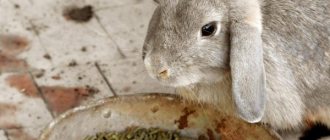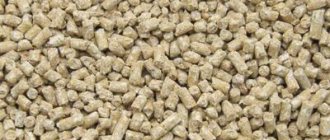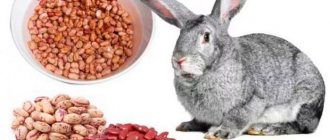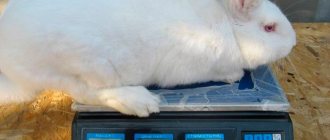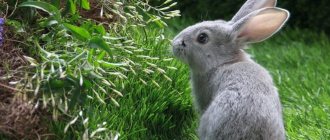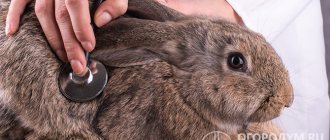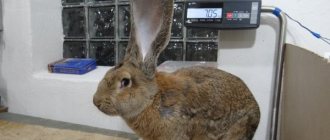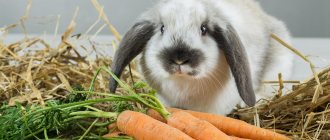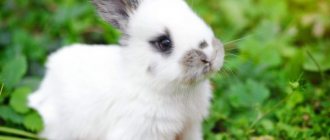Livestock » Rabbits
2
6515
Article rating
Kira Stoletova
To raise healthy and strong animals, you need to know the features of their diet. How many times a day should rabbits be fed? Let's look at what and in what quantity should be given to long-eared animals so that problems do not arise in the future.
Rules for feeding rabbits
Nutrition Basics
It is difficult for novice livestock breeders to understand the intricacies of breeding, so they often make certain mistakes. No need to calculate the ratio of proteins and carbohydrates per month on a calculator. Knowing the basics of feeding can help you avoid trouble.
- Quality products. It is forbidden to feed rotten or moldy food. Soaked, frozen or frost-covered food is a source of disease.
- Varied menu. Even the most delicious diet quickly becomes boring. Rabbits are more sensitive to food, so it is important to offer them a variety of foods.
- Water. Dry food is better digested only with an abundance of fresh liquid. The lack of an important element is first reflected in the form of constipation and lack of milk in lactating females.
- Food is given at a certain time. Animals quickly get used to the schedule and wait for food.
- You cannot feed all groups the same. The daily intake for each type of rabbit is different.
Long-eared animals eat at least 30 times within 24 hours. According to the Mikhailov system, animals have regular access to products. In nature, a rodent constantly finds twigs or grass, so the body receives nutrients in sufficient quantities. In this case, the livestock grows healthy and strong, without a single hint of obesity.
When kept in cells, they necessarily receive not only plant food, but also animal products. Experienced breeders provide fish oil, bone meal and whole milk with whey. It is useful to give silage with the addition of beets, potatoes and concentrate. Be sure to include microelements.
Carbohydrate needs
Carbohydrates are divided into two groups: fiber and nitrogen-free extractives (NFEs). In this case, fiber includes cellulose, hemicellulose and lignin, and non-fuel materials include sugar, starch, part of hemicelluloses, organic acids, etc. These easily digestible carbohydrates (especially sugar and starch) are sources of energy and play an important role in regulating metabolism in rabbits. When they are deficient in rabbits’ diets, protein-fat metabolism is disrupted, and acidosis occurs due to an increase in the level of ketone bodies in the blood and a decrease in its reserve alkalinity.
Fiber is the main source of indigestible organic matter. Both low and high levels of its content in the dry matter of rabbit feeds negatively affect the nutritional value of diets. At a low content (<6%), rabbits experience gastrointestinal upset, and at a high content (>20%), the level of digestibility of the main nutrients of feed sharply decreases. Experts believe that the optimal level of fiber in the diets of females is 12-15% of the dry matter of feed, and in the diets of young animals for fattening - 8-10%.
Feeding mode
Rabbits eat very often, so it seems to beginners that the animal is constantly chewing on something. Farmers prefer two meals a day: morning and evening. At home, they practice feeding food three times a day:
- in winter - at 8, 12 and 17 o'clock;
- in summer - at 6, 15 and 19.
Rabbit diet
In cold weather, in the morning and evening, give half the ration of concentrate (grain) and the same amount of silage. At noon it is better to feed with root vegetables. In warm seasons, at the beginning and end of the day, preference is given to dry food (50%) and grass. Dried greens are divided into 3 portions and added each time.
This diet will help to quickly build muscle mass in animals. Always check the availability of drinking water. In cold weather, the liquid must be warmed to room temperature.
Differences in diet in summer and winter
In spring and summer, rabbits need green grass. Thanks to this food they will receive the right amount of vitamins.
It is important to note that the herbs are always different. Plenty of water should be given at this time.
If there is a lack of moisture, rabbits may begin to get sick. During the cold period, it is necessary to increase the calorie content of food. Green food is replaced with hay and mixed feed. The water must be warm. Otherwise, the animals may catch a cold. Do not allow food to freeze in animal feeders. Newborn and 1-month-old rabbits are fed exclusively with mother's milk. The diet of children should not vary depending on the time of year.
How to feed?
It is best to have a balanced diet. In order to calculate the correct diet, you need to know the size of the animal, health status and age. Based on these factors, the daily requirement of nutrients and vitamins is calculated. A properly selected diet affects the health, growth and fertility of the animal.
Winter diet structure
It is important to know how many grams of feed should be given in winter. Adult female and male during rest:
Adult female and male during rest:
- Rough food – 145-155 gr.
- Compound feed – 55-65 gr.
- Vegetables/fruits – 145-155 gr.
- Chalk and salt - 1 g each. in a day.
Adult female and male during intercourse:
- Rough food – 145-155 gr.
- Compound feed – 75-85 gr.
- Vegetables/fruits – 195-205 gr.
- Chalk and salt - 1 g each. in a day.
Succulent female:
- Rough food – 245-255 gr.
- Compound feed – 85-95 gr.
- Vegetables/fruits – 295-305 gr.
- Chalk and salt - 1 g each. in a day.
Female after suckling (first 2 weeks):
- Rough food – 195-205 gr.
- Compound feed – 95-105 gr.
- Vegetables/fruits – 395-405 gr.
- Chalk and salt - 1.5 g each. in a day.
The female is suckling after giving birth. Supplementary feed for newborns:
- Rough food – 15-20 g.
- Compound feed – 10-15 gr.
- Vegetables/fruits – 35-45 gr.
- Chalk and salt are excluded.
Young animals that have reached 2-3 months:
- Rough food – 55-85 g.
- Compound feed – 30-45 gr.
- Vegetables/fruits – 95-155 gr.
- Chalk and salt - 0.5 g each. in a day.
Young animals that have reached 3-4 months:
- Rough food – 95-105 g.
- Compound feed – 50-65 gr.
- Vegetables/fruits – 295-305 gr.
- Chalk and salt - 0.6 g each. in a day.
Young animals that have reached 4-5 months:
- Rough food – 145-155 gr.
- Compound feed – 75-85 gr.
- Vegetables/fruits – 345-355 gr.
- Chalk and salt - 1 g each. in a day.
Fattening animals:
- Rough food – 145-155 gr.
- Compound feed – 95-125 gr.
- Vegetables/fruits – 95-155 gr.
- Chalk and salt - 1 g each. in a day.
Summer feeding ration structure
It is important to know how many grams of feed should be given in the summer. Adult female and male during rest:
Adult female and male during rest:
- Fresh grass – 595-705 gr.
- Concentrated food – 25-35 g.
- Salt and chalk - 0.5 g each. in a day.
Adult female and male during intercourse:
- Fresh grass – 755-805 gr.
- Concentrated food – 35-45 g.
- Salt and chalk - 0.5 g each. in a day.
Succulent female:
- Fresh grass – 795-805 gr.
- Concentrated food – 55-75 g.
- Salt and chalk - 0.5 g each. in a day.
Female after suckling (first 2 weeks):
- Fresh grass – 855-905 gr.
- Concentrated food – 75-105 g.
- Salt and chalk - 0.75 g each. in a day.
The female is suckling after giving birth. Supplementary feed for newborns:
- Fresh grass – 65-105 gr.
- Concentrated food – 7-11 g.
- Salt and chalk are excluded.
Young animals that have reached 2-3 months:
- Fresh grass – 295-305 gr.
- Concentrated food – 15-30 g.
- Salt and chalk - 0.25 g each. in a day.
Young animals that have reached 3-4 months:
- Fresh grass – 495-505 gr.
- Concentrated food – 40-55 g.
- Salt and chalk - 0.25 g each. in a day.
Young animals that have reached 4-5 months:
- Fresh grass – 555-560 gr.
- Concentrated food – 80-100 g.
- Salt and chalk - 0.25 g each. in a day.
Fattening animals:
- Fresh grass – 195-205 gr.
- Concentrated food – 145-185 g.
- Salt and chalk - 0.5 g each. in a day.
You can prepare a grain mixture for feeding a rabbit at home (see video)
Fattening
Meat breeds are raised according to a certain pattern. It is important to not only gain weight in a few weeks, but also get an excellent ratio of meat and fatness. Experienced livestock breeders recommend starting the process 42 days before the expected slaughter.
What and how many times a day should you feed rabbits? More than 50% of the menu consists of concentrates, and to increase fat it is recommended to feed boiled potatoes, corn and barley. Sometimes peas and oats are allowed, and parsley and dill are mixed with hay.
Animals should move less and gain weight faster. To do this, their movement is limited to a cage in which no more than 6 eared heads sit. They are sent to slaughter after the individuals become lazy and have little interest in food.
FEEDING AND WATERING RABBIT
From the Editor This article was sent by our forum member Danila. The material was taken from the book “Rabbit Breeding”, apparently published in the late 50s, early 60s of the 20th century. The author of this publication is Nikitin. Special thanks to Danila
A rabbit is a rodent by nature. His front teeth (incisors) grow throughout his life and therefore there is always a need to grind them down, that is, to gnaw something. Otherwise, the incisors would grow so large that the rabbit would not be able to close its mouth.
In the wild, rabbits feed on various greens: grass, leaves, shoots of trees and shrubs, all kinds of seeds and roots. A wild rabbit instinctively selects from the surrounding plant world everything necessary for its reproductive existence.
The conditions are completely different for rabbits in a domesticated state, when the choice of food and, in general, their feeding regime depend entirely on the care of the person caring for them. A rabbit, like a bird, is very voracious - it can eat day and night. This is understandable: being a precocious animal, with the ability to reproduce quickly, the rabbit requires a lot of varied food. In order to properly organize the feeding of rabbits, it is necessary, in accordance with their natural needs for various feeds, to create a food regime that, at the lowest cost, would fully satisfy the animals and ensure the successful implementation of all production processes associated with their breeding. Based on this, rabbits should be fed with voluminous food ad libitum, and more nutritious food should be given, strictly adhering to the established norms.
The main food for rabbits in the summer is all kinds of greenery - grass, leaves, branches of trees and shrubs, tops and other garden waste.
It is especially beneficial to give them twig food - willow grass, aspen, hazel, linden, white acacia, and from garden waste - tops of carrots, radishes, turnips, rutabaga, turnips, sunflower leaves, kale, etc.
Seed herbs, without exception, are excellent green food for rabbits.
Rabbits are very fond of bitter and aromatic plants: wormwood, yarrow, chicory, wild rowan, dill, etc. These plants, as well as pine branches, are useful to add to the diet, as they protect against helminthic diseases and increase the activity of glands associated with digestion.
Nettle is one of the first to begin its growth and development in the spring. Therefore, this is where you should start feeding your rabbits greens. To prevent the nettle from burning the animal’s mouth with its hairs, it should be chopped and crushed before distribution.
Almost simultaneously with the nettle, the willow (willow) begins to bloom. It is especially useful for young animals to be given green willow branches, starting from the suckling period, as they have a strengthening effect and protect against diarrhea.
Talnik is well eaten by rabbits and serves as the best transitional green food to grass. Therefore, when organizing a cheap and healthy food supply for the widespread development of rabbit breeding, we can recommend mass planting of willow grass along the banks of rivers, streams and ravines, where other crops are not produced.
In winter and early spring, nursing females should be given one of the root vegetables: carrots, beets, turnips, rutabaga or Jerusalem artichoke as a vitamin supplement and milk extractor.
Nettles, harvested before flowering and dried in bunches in the shade, can serve as a good vitamin food. Nettle hay replaces concentrates to some extent.
Rowan berries are an excellent vitamin supplement, which are easy to prepare in the fall in the places where they grow. Rabbits eat bitter rowan berries with great eagerness.
A good juicy and vitamin-rich food for rabbits, as well as for other animals, is high-quality silage made from grass, corn or sunflowers, which should be fed in light frosts, since wet silage quickly freezes during distribution and then becomes unsafe. Kale is an excellent autumn food. It is not afraid of frost and, therefore, allows you to extend the feeding of rabbits with green food.
As a vitamin supplement, you can also recommend branches of coniferous trees or an infusion of pine needles, which is obtained by steaming small coniferous branches with boiling water several hours before use by rabbits. This infusion is added to boiled potatoes, moistened with bran, and sprinkled with hay. Coniferous branches are given to rabbits once a day and little by little. Feeding large quantities of branches can cause gastrointestinal illness.
During the winter period, rabbits should be given fine hay with the addition of wood (preferably aspen) branches approximately the thickness of an arm.
They eat the bark from the branches, and the wood can be used for fuel. The introduction of twig feed into the diet significantly saves hay. To make it easier for rabbits to endure long winter nights, in the evening it is good to give them not only hay, but also thick, freshly chopped branches.
In addition to roughage and succulent feed, rabbits at some periods of their lives also need concentrates and mineral feeds.
Instead of grain, you can use various grain waste, small potatoes and even potato peelings. When feeding potatoes or peelings, you must first boil them, drain the water, mash and lightly salt, mix well, cool and only then distribute.
It is very useful to give rabbits ears of corn that have reached milky, or even better, waxy ripeness. Animals eat them with great appetite, both raw and ensiled.
If it is possible to obtain a mulberry or oak silkworm pupa (waste from silk-reeling production), then it can successfully replace concentrates and serve as a very useful animal feed not only for rabbits, but also for chickens and ducks. The silkworm pupa is extremely nutritious, as it contains 60% digestible protein and over 20% fat.
The experiment carried out at the Biryulinsky state farm of feeding silkworm pupa, previously steamed in salted water, to rabbits of different ages and conditions gave excellent results. This new type of protein feed for rabbits is now used by many rabbit farms on state farms. Feeding silkworm pupa has a particularly beneficial effect on the growth and development of baby rabbits. At the age of 1-2 months it is recommended to feed it 6 g, and at the age of 3-4 months - 8-12 grams per head. As it turned out, the silkworm pupa is nutritious not only in itself, but also its juice, which contains special substances that promote better absorption of other foods by the rabbits’ body, thereby increasing their nutritional value.
Most feeds are supplied in dry form, with the exception of those that are difficult to chew - waste of peas, lentils, vetch, corn, cakes, which are soaked in water several hours before use.
Bran, feed and flour waste should also be moistened with lightly salted water and given mixed with boiled potatoes or oats.
Before feeding, root vegetables should be washed well, rotting parts removed and cut into pieces weighing approximately 100 g. Such pieces are easy to check for quality, convenient to distribute to rabbits, and they will not quickly freeze during feeding in winter.
Whatever food is fed to rabbits, you must always ensure that it is of good quality and is given in clean containers. Under no circumstances should you use sour, moldy or musty feed, as it causes massive gastrointestinal diseases and large waste, especially of young animals.
The quality and nutritional ratios of feed for rabbits are determined depending on the fatness and size of the latter. On the other hand, during mating, pregnancy, feeding of suckling rabbits by females, growth and development of young animals, and, finally, when fattening rabbits for meat and skin, they require different amounts of feed
The table shows that during the rest period, adult livestock are given maintenance, mainly cheap, bulky and juicy feed.
During mating and other production periods, when there is no green food, it is necessary to add grain waste or boiled potatoes, or silkworm pupa (the latter is 5 times less than oats) to the hay.
The composition of most tissues from which the animal body is formed primarily includes protein. It follows that the feed rations should include a sufficient amount of digestible protein, or rather one part of the protein contained in this type of feed, which is absorbed by the rabbit’s body. However, excessive amounts of protein in feed are extremely harmful to the condition of animals and can even cause protein poisoning.
The most useful ratio of digestible protein to feed units is 1:10, as shown in the table.
The absorption of feed is further facilitated by drinking plenty of water, as well as vitamins and minerals that are part of various body tissues.
With a lack of vitamin A, rabbits are easily susceptible to all kinds of diseases, females become idle, and young animals lag behind in growth and development. A lack of vitamin B disrupts the normal activity of the nervous system, on which the rabbit’s expedient behavior primarily depends. With a lack of vitamin C, the activity of the digestive organs sharply decreases, which entails metabolic disorders. There is a lot of this vitamin in green and succulent foods.
With a lack of vitamin D, rickets appears in all its manifestations.
Vitamin D is formed in the animal itself under the influence of chemical (ultraviolet) rays from the sun. A lot of it is found in legume hay, such as alfalfa. With a lack of vitamin E, the activity of the reproductive organs is disrupted - sperm formation in males is delayed, and fertility in females is sharply reduced. There is a lot of this vitamin in green feed, grain sprouts, and alfalfa hay.
In order to familiarize rabbit breeders with the content of minerals and vitamins A and B2 in basic rabbit feeds, the table above is given (data from the Poultry Research Institute).
It should be noted that fur seals and short-haired rabbits in general need minerals and vitamins more than other breeds for their normal growth and development. This must be kept in mind when breeding them.
In addition to the vitamins already listed, there are others that in one way or another affect the animal’s body. Of these, the recently discovered vitamin B12 is of particular practical interest, increasing vitality and influencing the growth and development of the body and the formation of hemoglobin in the blood. In addition, vitamin B12 has a beneficial effect on fattening animals. It is found in milk, meat and bone meal, silkworm pupa and other animal feed.
Rabbits should be fed at least three times a day: in the morning (after dawn), at noon and before dusk.
Particular attention should be paid to feeding suckling queens and weaned young animals. To prevent rabbits, and especially baby rabbits, from overeating on greenery, they should always have fresh grass or branches in their cages and enclosures. In the spring, rabbits should be accustomed to greens gradually, first feeding willow or nettle mixed with hay, then grass, because rabbits greedily attack greens and gorge themselves on it so much that their digestive organs are not able to cope with the abundance of green mass received. As a result, there is a loss of young animals. For the same reason, rabbits should not be given large quantities of tops of garden plants and cabbage leaves.
Rabbits quickly get used to the time of distribution of food and water and become anxious if they are not fed or given water on time. We must never forget that rabbits patiently and silently endure hunger and other hardships. All their lives they are kept in cages or enclosures, that is, they are entirely under the care of the rabbit breeder. Their health depends entirely on care and attentive attitude towards them. Therefore, in rabbit breeding, a careful individual approach to feeding and watering is especially important.
Rabbit breeders often do not take into account the number of rabbits under the female, the age and number of young animals in the enclosures when distributing feed and water. Large families and groups especially suffer from this inattention, in which rabbits appear exhausted and developmentally delayed, easily susceptible to all kinds of diseases. We must remember that proper individual feeding is the main condition for obtaining high quantitative and qualitative indicators in raising young animals.
In addition to the obligatory feed for rabbits, which is hay in winter and greens in summer, on individual farms they can be fed crusts and scraps of bread, leftover porridge and even meat soup. You just need to make sure that the scraps and leftovers from the table are of good quality - not sour or moldy.
For better development of young animals, it is useful to give them milk. By organizing feeding in this way, Kazan, Smolensk and Moscow amateur rabbit breeders brought the live weight of black-brown, veil silver, white downy and other breeds and breed groups of rabbits imported from the Biryulinsky state farm to 8 kilograms or more.
Rabbits should be watered daily throughout the year with fresh and clean well or spring water. Water from ponds, swamps, rivers and other open bodies of water can cause various diseases.
During the hot season, all rabbits, and the rest of the time only nursing females, need to be watered at least twice a day. On cool days, young animals, males and non-breastfeeding females, are watered once a day, and in damp weather, if there is abundant green food, it is better not to water the young animals at all, since they receive enough moisture along with the succulent grass.
The experience of the Solntsevsky state farm, proposed by livestock specialist I. A. Vachugov, tested at the Biryulinsky state farm, showed that it is especially useful for young rabbits to be given heated water. Cold water often causes inflammation of the gastrointestinal tract and can cause rabbits to waste. This should be taken into account and before drinking, heat the water in the sun or in a boiler.
For better digestion and warming the body in winter, and in summer to avoid colds, it is useful to give water to rabbits of all ages water heated to room temperature.
Differentiated feeding and feeding play a decisive role in creating the most favorable living conditions for animals and dramatically increase the reproduction of high-quality young animals. Therefore, many years of experience in thoughtful individual feeding of rabbits on the selective breeding rabbit farm of the Biryulinsky State Farm is of interest for use in other rabbit breeding farms.
Feed for distribution to rabbits is received by female rabbits depending on the number of rabbits, taking into account the daily routine, age groups and condition of the breeding stock. However, in order to correctly distribute food among rabbits, one must have observation and the art of measure, thanks to which differentiated feeding is achieved. These are the qualities that the female rabbits of the Biryulinsky state farm have mastered to perfection. Before feeding, mother rabbits, as a rule, first clean the cages and water the rabbits, and then distribute the food.
When distributing, the condition of fatness, and age are taken into account, whether the female is nursing, and how many and how old the rabbits are under her, and if food is distributed to separated young animals, then how many heads are in the group and how many months old they are. In accordance with this, food is distributed - more to some, less to others. At the same time, the mothers carefully monitor that they do not get any rotten, moldy or sour food, which causes serious illnesses in rabbits, and especially among pregnant females and separated young animals.
When the food has been distributed, the mother rabbit once again goes around all her cages and enclosures to check whether she has somehow accidentally missed any rabbit and whether it is sitting hungry, waiting for its portion. Here, by the way, she observes how quickly which rabbits ate their food. This is taken into account during subsequent feedings. For those rabbits that eat especially quickly, an experienced rabbit mother always leaves extra food when distributing.
Rabbit mothers pay special attention to lactating females and newly placed rabbits, who are most in need of skillful feeding. They try to give the month-old young animals better-eaten, tender food: in summer, forbs with the addition of wormwood, and in winter, fine, well-leafed hay. In the spring, during the transition from hay to green food, young animals are given branches of blossoming willow grass, and adult rabbits are given finely chopped nettles. The silkworm pupa (waste from silk-reeling production), which he receives from Central Asia or the Caucasus, gives a great effect when raising young animals on the state farm.
The silkworm pupa is steamed in salted water and added to concentrates or small boiled potatoes at the rate of 10 grams per head.
Much attention is paid to timely watering of rabbits with clean and fresh water, which they readily drink at all times of the year, regardless of the season. Even in winter, when it’s very cold, rabbits are happy to drink warm water. When the farm introduced drinking warm water in winter instead of the usual distribution of snow, patients with rickets disappeared, and the rabbits began to eat dry food better. This is not surprising. Water contains many minerals that are completely absent from snow.
At the rabbit breeding farm of the Biryulinsky State Farm, rabbits are fed and watered at strictly established times, according to the daily routine. In summer, rabbits are fed 5 times a day, of which 3 times (morning, afternoon and evening) with grass and generally green food and 2 times with concentrates (morning and at night); They drink three times a day in the summer, and 2 times a day in the winter. In winter, rabbits are given hay twice, root vegetables or silage once, concentrates in the morning and small boiled potatoes with silkworm pupae at night.
Diet during mating
To get healthy and strong rabbits, you need to take care of the condition of the future parents. Thin people are provided with enhanced nutrition, and fat people are put on a diet. Too little or too much fat leads to stillbirth and reduces sperm quality in males.
Enhanced feeding of exhausted individuals begins a month before the mating period. It is necessary to increase the daily diet, bringing it closer in nutritional value to the menu of pregnant women. Abundance and variety are complemented by multivitamins.
To improve sperm quality in males, you need to use protein foods. To enrich food, oilseed cake, meat and bone meal and fish meal are added. During the mating period, you should not use products that contribute to obesity, therefore exclude:
- barley;
- corn;
- potato.
The viability of the rabbits depends on the health of the producing animals. It is advised to provide a nutritious and varied diet with a sufficient amount of useful microelements. Veterinary supplements can be used at this stage.
What should a rabbit eat during the rest period? A typical diet consists of one-third grain and 70% hay. Added to food (in grams per head):
- salt - 1;
- bone meal - 4;
- ground shells - 2.
Features of the female menu
A pregnant rabbit eats a lot. Obese mothers find it difficult to give birth. Before giving birth, the daily allowance is reduced, but starvation is not allowed. Lack of nutrients leads to a delay in the natural development of the fetus.
One female rabbit eats from 60 to 100 g of plant food (oats, concentrate, legumes) per day. Additionally, add sunflower or soybean cake - no more than a third of the norm. Since there is no lactation yet, half a kilogram of grass is enough.
Don’t forget about carrots and potatoes: 250 g per head. Pregnant females must be given minerals and vitamins, and fish oil and meat and bone meal are suitable as natural supplements. It is important to monitor water quality.
After childbirth, you need to increase lactation. A nursing rabbit eats green grass in the summer, and in cold seasons it is better to feed root crops, hay and silage. Feeding rates increase in the period from 20 to 45 days (in grams per individual):
- mixed feed - 150;
- juicy menu - 300;
- grass - 1000.
Lactating females need to consume 60-70 g of protein per day in food. Their food should contain at least 17-18% of the important product.
The babies watch their mother and soon begin to try adult food themselves. To prevent the rabbit from starving, you need to add 30 g of concentrate and hay to the daily dose in winter, and 25 and 60 g in summer. In this case, you don’t have to worry about a lack of food and a decrease in lactation.
Types of feed
The industry produces two types of combined feeds for rabbits:
- PC – fully rationed feed. Their composition fully satisfies all the needs of the animal body for nutrients, vitamins and microelements. When using this feed there is no need for additional feeding.
- Concentrated feeds are sold under the designation K or KK. This feed supplements the basic diet of animals with protein, fiber and minerals.
Different feed options are available for different ages of animals:
- for fattening young animals aged from one to five months, PK 90, PK 91, K91 are used;
- for feeding adult rabbits use K 92-1 and K 92-2;
- For final fattening of animals for meat, K93-1 compound feed is used.
Compound feed goes on sale in two states:
- granulated. An excellent option for complete feeding. Excellent storage, easy to dose, convenient for animals to eat;
- bulk mixtures. All components in them are ground into powder. It is most convenient to use them in mash.
On a note!
Feeding feed intended for other animals or birds can be harmful to rabbits due to the specific additives included in it.
Features of the young cattle menu
Feeding rabbits has its own subtleties. It is better to place babies in the period from 30 to 45 days after birth. If you are deprived of mother's milk at an earlier age, the digestive system of young people will not have time to form correctly. Any “adult” diet is not suitable for eating crumbs, so everything new is introduced gradually.
Fattening young rabbits
Experienced farmers prefer to use granular concentrate. The daily feed intake for young rabbits is (in grams per head):
- up to 2 months - from 85 to 125;
- up to 90 days - from 130 to 170;
- from week 13 - from 180 to 200.
By the way, the menu can be varied with greens and hay. Feed is reduced to 85%, and the remaining 15% is used for grass. In the morning, give half the daily allowance of dry food, and in the evening add root vegetables to the rest. During the day, it is recommended not to forget about silage. Wet foods are given in such a way that they are eaten within 1.5 hours.
Energy requirement
The energy requirement of rabbits, per unit of live weight, in comparison with other domestic animals, is significantly higher. When rationing the feeding of rabbits using a factorial method, energy costs for maintaining life and energy costs associated with various physiological states (lactation, pregnancy, growth, development, etc.) are distinguished. For example, during the mating period, the diet of males in terms of energy indicators must be increased, in comparison with the supporting feeding background, by 40%. The diets of females at the beginning of pregnancy according to this indicator are increased by 30%, and in the second half they are increased to two norms of maintenance energy. During lactation, the need for energy increases sharply. During 2, 3-4, 5-6, 7-8 weeks of lactation, the rabbits’ energy requirement is respectively 200, 300, 400 and 600% of the maintenance level of the diet.
According to foreign experts, the norm of maintenance energy for adult rabbits with a live weight of 3 kg is 280 kcal (1.15 MJ), 3.5 kg - 320 kcal (1.32 MJ), 4 kg - 350 kcal (1.44 MJ), 4.5 kg – 380 kcal (1.56 MJ). At the same time, 100 g of feed for adult rabbits should contain at least 250 kcal (1.05 MJ), but not more than 270 kcal (1.13 MJ) of metabolic energy, and for young animals - accordingly, at least 280 kcal (1.17 MJ) ), but not more than 320 kcal (1.34 MJ).
Summer feeding
Warm seasons are a great time to diversify your animal menu. The basis of the diet is both grass and radish and carrot leaves. Eared beetles are good at absorbing branches of fruit tree varieties. It is not prohibited to offer apples, cabbage and waste from them.
Sugar and red beets should not be given in large quantities. Products cause increased gas formation, which leads to bloating. It is allowed to use fodder types of root crops. To improve digestion, give fragrant herbs:
- sagebrush;
- dill;
- yarrow;
- chicory.
Dried garlic stalks are used to prevent dental problems, and plantain is a natural antibiotic. Young nettle will become a natural source of vitamins. By the way, such a delicacy can be given to both a nursing rabbit and meat rabbits.
How much greenery is allowed per pet? On average, adults eat up to 600 g of grass, rabbits - from 150 g and more. Keeping lactating mothers allows you to increase the norm by 2 times. Using this type of diet reduces the consumption of dry food and saves concentrates.
Winter feeding
During cold seasons, animals often experience vitamin deficiencies. Microelements A, D, E and B12 must be added to the daily food intake for rabbits. High-quality hay and fermented green food will provide the body with important components. Fish oil is added once a day (in grams per head):
- rabbits - 0.5;
- lactating females - 3;
- pregnant women - 2;
- for other animals - 1.
Sprouted grains are rich in vitamin E, so they are regularly given to both children and adults. If you don’t have time to grow greens, then sometimes you can replace them with yeast. For 5 days, one individual is fed up to 6 g of baking product. Then they take a break for 72 hours and repeat again.
What to feed rabbits in winter
Turnips, cabbage and dry grass are fermented in barrels for the winter. Add carrots and salt (1% of the total mass). An adult animal should have no more than 300 g of such food, while 100 g per head is enough for young animals. To prevent vitamin deficiency, experienced farmers sometimes give needles of coniferous crops.
How much should a rabbit eat in winter? During this period, 50% of the total diet consists of concentrates, and the rest is silage and succulent foods. Carbohydrates that can be obtained from boiled root vegetables are perfectly absorbed.
Types of feed
All rabbit food can be classified into one of three types:
- Roughage. These include grass, vegetable tops, cabbage, hay and tree branches. In winter, hay stored in the summer is fed as roughage. Roughage is the main supplier of fiber to animals.
- Juicy feed. These are root vegetables, silage, pumpkin, zucchini. As a rule, succulent feed ends up in the animal feeder during the winter. They serve as an essential source of vitamins, but are poor in fiber and protein. In lactating rabbits, large quantities of succulent feed increase the amount of milk.
- Concentrated feed. These include cereal grains and legumes, bran, cake, mixed feed, and animal feed. Concentrated feeds are rich in protein but poor in vitamins. With an increase in the dose of concentrated feed in the diet, the growth rate of animals increases.
Things to remember
Long-eared pets love to chew on something, so you need to be careful about food of animal origin. Dairy products are included in the menu in limited quantities. For one individual, 10 g per day is allowed, which is used both raw and added to mash.
The rabbit must eat grain, but experienced farmers advise pre-grinding large grains in a crusher. Such food is easily digestible and does not cause rejection in young animals. During feeding, you need to carefully monitor your pet’s taste preferences and not let unloved ingredients be scattered.
Eared animals should not eat fresh bread. It is better to cut the product into small pieces and dry it in the oven. Crackers are used as an additional treat. Do not get carried away with table waste and give food with an abundance of spices and salt.
Autumn and spring are a period of transition from one type of food to another. It is not recommended to carry out the procedure abruptly, otherwise it can cause digestive problems. Gradual introduction of new types of food should be done over 7 days. If diarrhea begins, then the animals should be given oak branches.
Knowing the daily feeding rates for rabbits per head, you can accurately calculate the consumption of a particular product per month. Our recommendations will help you find the optimal menu for each stage of animal life. Thanks to knowledge of seasonal characteristics, it is easy to adjust your diet.
What is compound feed, its advantages and disadvantages
Compound feed is a crushed and mixed mixture of plant and animal feed. During the cooking process, vitamins, macro- and microelements are added to it. For better absorption by the animal’s body, all components are selected according to their chemical composition, complementing each other. For each type of animal, feed is produced according to its own recipe.
Advantages:
- reduces time spent on feeding animals;
- easy to transport, convenient to store;
- feeding with compound feed makes the animal’s diet balanced, preventing health problems;
- the feed contains many components, thereby providing variety in animal nutrition;
- The vitamin premixes included in the feed save animals from vitamin deficiency.
Flaws:
- excessive amounts of feed leads to obesity in animals;
- compound feed – soft food. If they replace the bulk of the food, the rabbits' incisors will not wear down. This will lead to problems with the gastrointestinal tract;
- the cost of purchased mixtures is quite high.
